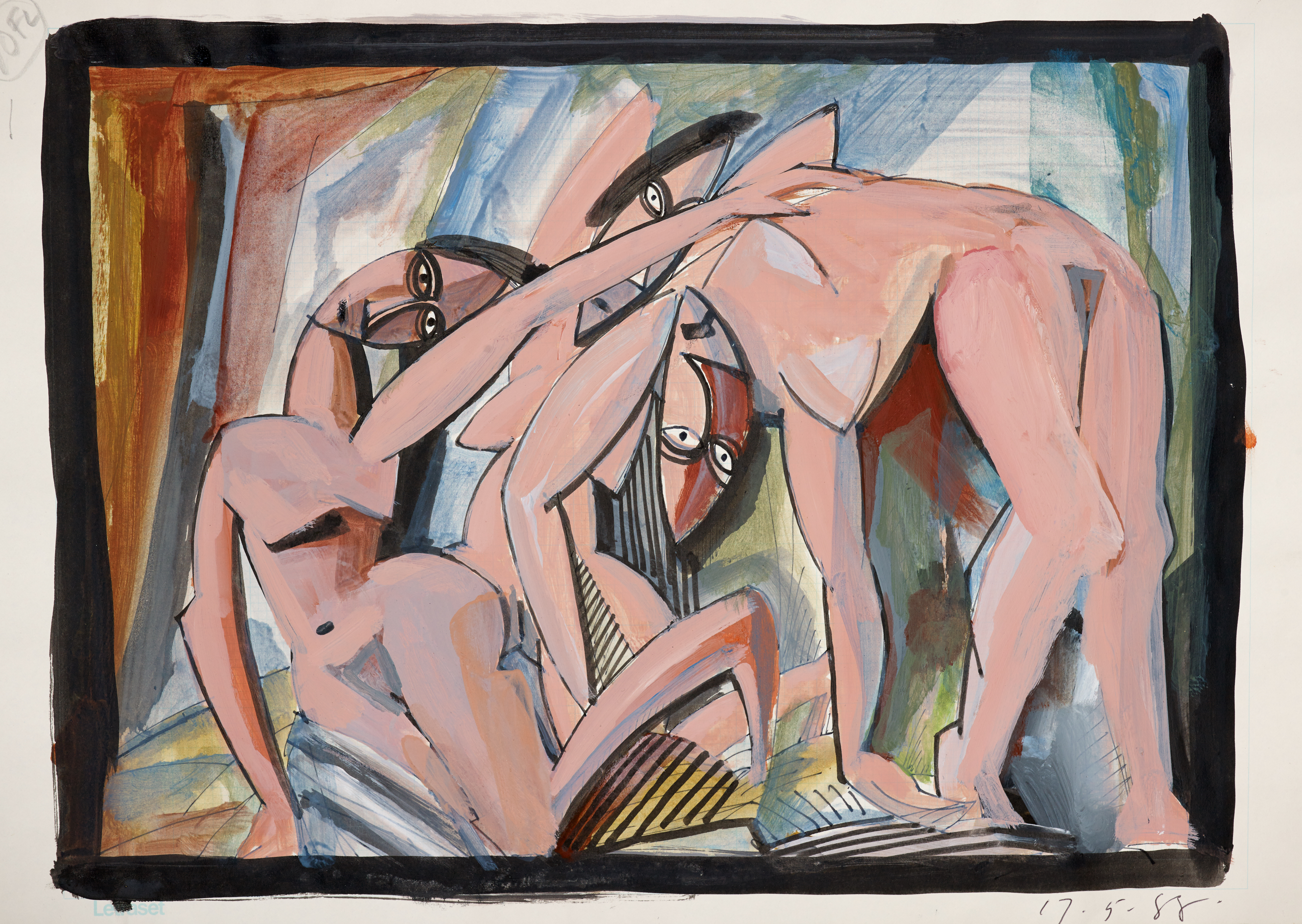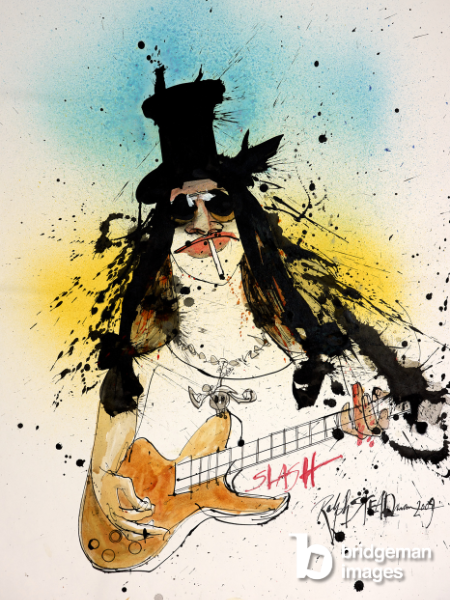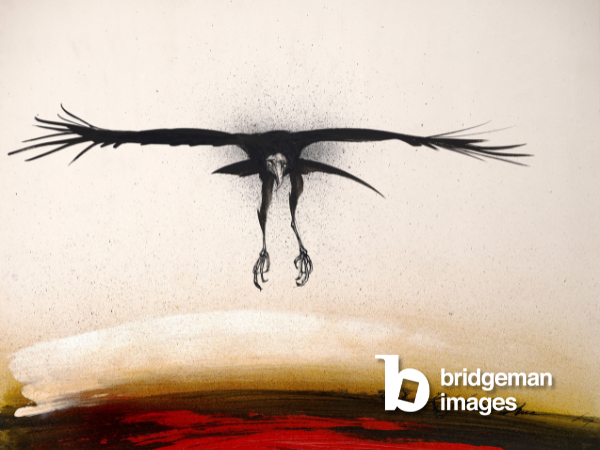
Ralph Steadman - Artist Spotlight
Ralph Steadman is a prolific artist, who in his 60-year career has produced thousands of groundbreaking and influential artworks. Born in 1936, Ralph Steadman began his career as a cartoonist and through the years diversified into many fields of creativity. Artist, writer, sculptor, cartoonist and designer, he has illustrated such classics as Alice in Wonderland, Treasure Island and Animal Farm. His books include the studies of Sigmund Freud and Leonardo da Vinci, while with Hunter S. Thompson he collaborated on the birth of Gonzo journalism with his classic illustrations for Fear and Loathing in Las Vegas.
One of Ralph’s favourite pastimes growing up was to make model aeroplanes. He would rush home from school and would always complete any outstanding homework before allowing himself to indulge in his hobby. This work ethic has remained with him and later, when he began working with Hunter S. Thompson, would lead to no end of irritation to his tall, trans-Atlantic friend when Ralph would often have completed his drawings before Hunter had written a word.
Click here to explore all images by Ralph Steadman
.png?width=450&height=600&name=Ralph%20Steadman%20(3).png)
Model Aeroplane making likely led him to his first job at de Havilland Aircraft Factory as a radar operator. It was here that he picked up the skill of technical drawing, a skill that has featured in his artwork throughout his career. He left de Havilland after a few months however, unable to bear the monotony of factory life. Having completed his National Service in 1954, during which time he completed the Percy V. Bradshaw Press Art School correspondence course, he moved to London and started work as a cartoonist. He went to meet Percy V Bradshaw once and commented that the course was a little old-fashioned. Bradshaw sagely responded: “the principles of drawing will always remain the same, dear boy.”
In 1959, frustrated by the limits of his skills, he enrolled at East Ham Technical College to learn the ‘discipline of drawing’. It was here he met his mentor, Leslie Richardson, who taught life drawing. 1960 saw his first appearance in Punch magazine, where he eventually progressed to cover design. In 1961, encouraged by Richardson, he enrolled at the London College of Printing. By this point he was beginning to find the demands of newspaper cartooning too restrictive: "Cartooning wasn’t just making a little picture and putting a caption underneath. It’s also something else – a vehicle for expression of some sort, protest, or it’s actually a way of saying something which you cannot necessarily say in words."
His first cartoon was published in the Manchester Evening Chronicle in 1956. As his career progressed, his work later appeared in a number of other newspapers including the New Society, Radio Times, Town, New Musical Express, the Daily Telegraph and the Daily Express..png?width=450&height=600&name=Ralph%20Steadman%20(5).png)
In 1961 he wrote to the editor of newly founded Private Eye and began to explore a new, more provocative style, drawing on influences like George Grosz and John Heartfield. During the 1960s he illustrated several children’s books, including Fly Away Peter (1964), The Big Squirrel and The Little Rhinoceros (1965), The False Flamingos (1967) and The Jelly Book (1967), which he also wrote. In 1967 he began work on his illustrated Alice in Wonderland, which won the Frances Williams Award in 1972. Steadman updated the classic Tenniel illustrations for the 1960’s turning the White Rabbit (featured below) into a commuter, perpetually late for work, the Mad Hatter became a union leader and the Caterpillar suddenly began to resemble John Lennon enshrouded in a fog of smoke.
His big break really came in 1970. Having published his first collected book of cartoons, Still Life with Raspberry, with it under his arm, he set off to America to cover the Kentucky Derby for Scanlan’s Monthly, where everything would change on his meeting Hunter S. Thompson. Described as “a Hell’s Angel who had shaved his head,” Steadman set off to meet this maverick journalist at the Kentucky Derby. Legend has it that it took them 3 days to find each other. Ralph often recalls that Hunter commented when they finally met, “well they said you were weird, but I did not think you would be that weird!”. Warned not to do any of his “filthy scribbling” Ralph almost caused a fight at the Pendennis Club in Louisville before being maced by Hunter to help him escape.
Together Ralph and Hunter would develop Gonzo journalism, where you do not simply cover the story but become the story. So began a lifelong collaboration, including the iconic Fear and Loathing in Las Vegas, which was originally serialised in Rolling Stone Magazine. Another lifelong association was begun, and Steadman is still listed as Gardening Correspondent for the legendary publication.
Between projects with Hunter, including Fear and Loathing on the Campaign Trial ‘72, The Curse of Lono (1983) and Polo is My Life (1994), and numerous pieces for Rolling Stone (seen below), Steadman continued to produce his own books, including Sigmund Freud (1979), I Leonardo (1983), The Big I Am (1998), as well as children’s books such as That’s My Dad (1986), No Room to Swing a Cat (1989) and Teddy! Where Are You? (1994).

In 1987 Steadman was approached by Gordon Kerr at Oddbins to travel the vineyards of the world and produce artwork for their catalogues. Gordon remains a friend and now writes condensed history books.
Between 1987 and 2000 he produced hundreds of artworks, many of which would eventually appear in his two award- winning books on wine, The Grapes of Ralph and Untrodden Grapes. He also explored his book about whisky, Still Life with Bottle. He has always diversified in his career, producing theatre sets for a ballet of The Crucible (2000) performed at the Royal Opera House; a production of Gulliver’s Travels (1995) for Clwyd Theatr Cymru; and an oratorio and images for an eco-opera, The Plague and the Moonflower, with music composed by Richard Harvey.
Click here to explore all images by Ralph Steadman
More recently he has illustrated three books about extinct and endangered birds and animals with Documentary film-maker and co-Gonzovationist Ceri Levy, Extinct Boids (2012), Nextinction (2015) and Critical Critters (2017). Levy approached him tentatively through another acquaintance, Lady Catherine St German’s whose husband, Peregrin started the charming Port Eliot Festival. He was putting together a show of artworks, The Ghost of Gone Birds, to feature extinct birds by a variety of artists and he asked if Steadman might submit a drawing of an extinct bird of his choice.
Levy often muses that he had no response for several weeks and suddenly four extinct birds appeared in his inbox and lo, the Gonzovation Movement was born. Steadman ended up producing over 100 images of extinct birds, and imagined birds, which Bloomsbury then published. Steadman’s artworks were all hung, side by side in rows in one room and binoculars were provided for the viewers to view them through. Following on from Extinct Birds they naturally decided to collaborate on a book about critically endangered birds, entitled Nextinction, and then on their third book together which focussed on endangered animals, Critical Critters.

In between all these Gonzovation projects, Ralph was asked by Vince Gilligan to create the collectors DVD Box Set artwork for his hit series, Breaking Bad. He produced portraits of seven of the cast members, six of which appeared as the DVD box covers. In 2012 a film of his life and influences, fifteen years in the making, called For No Good Reason premiered at the Toronto Film Festival to critical acclaim. Ralph is still drawing and producing art today, working regularly for the New Statesman, The Independent and the New York Observer, as well as working on his own projects. He is a maverick and trail blazer whose art inspires and influences artists today.
Click here to explore all images by Ralph Steadman

.png?width=450&height=600&name=Ralph%20STeadman%203%20(2).png)
-1.png?width=450&height=600&name=Ralph%20Steadman%20(3)-1.png)